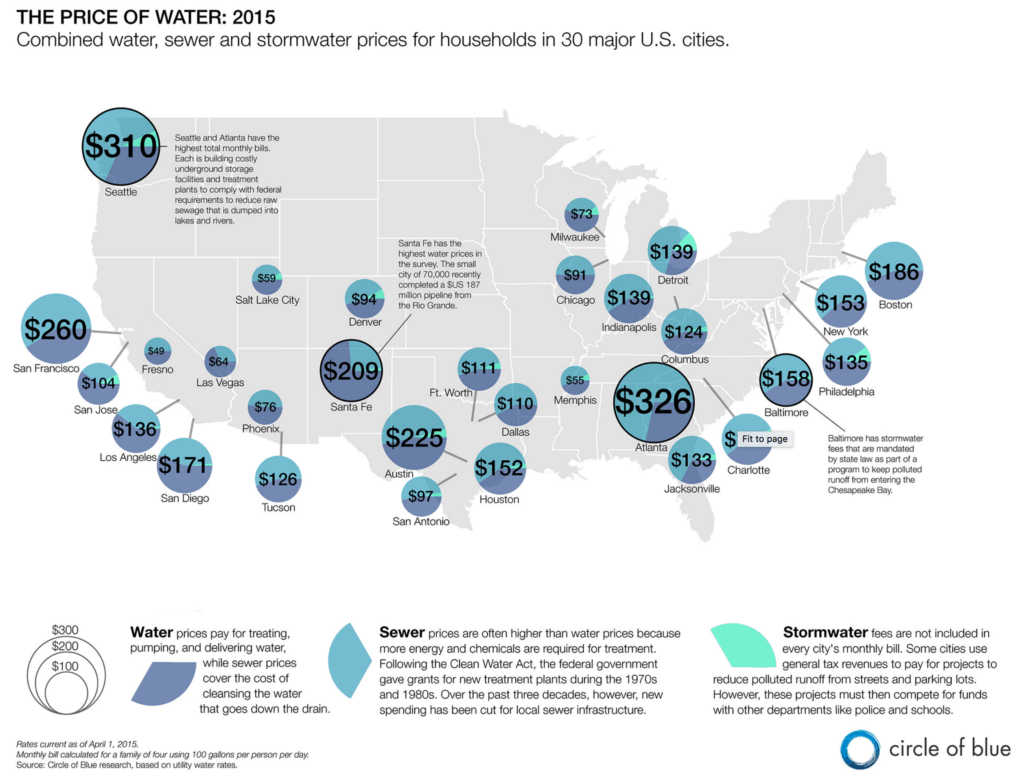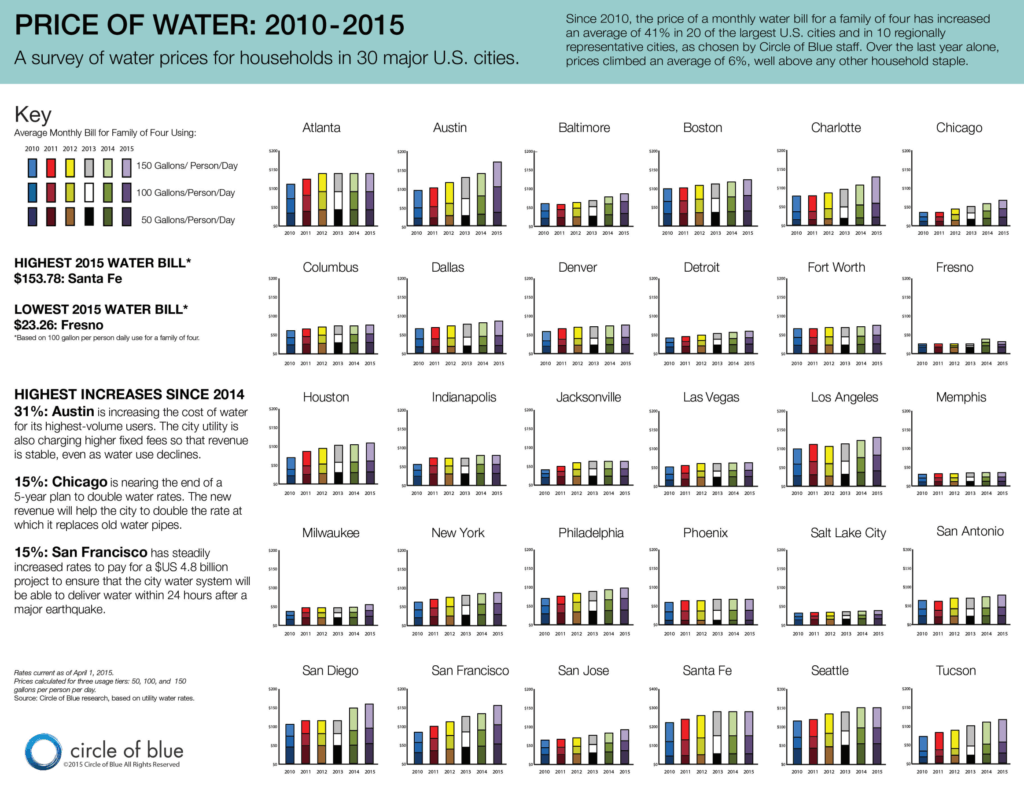REtipster features products and services we find useful. If you buy something through the links below, we may receive a referral fee, which helps support our work. Learn more.
In my years as a rental property owner, I've learned the importance of paying attention to costs.
There's one cost, in particular, that is very easy to overlook, yet it has the potential to sabotage the cash flow of every property I own.
The Water Bill.
In some cities, it's easy for landlords to make their tenants pay these bills directly, but in the city where I live (and in many others around the country), the property owner almost always pays this expense out-of-pocket.
Here's why…
- Any unpaid water bills will ultimately end up as a lien on the property (instead of collections to tenants). If a tenant ever stops paying – it's the property owner's problem, not the tenant's.
- In many cities, water bills are sent out quarterly (not monthly like gas and electric). This can make it difficult to determine which tenants should pay which portions of the bill when one moves out, and another moves in.
- Most cities don’t have sufficient systems to manage “landlord situations” very well. With ongoing tenant transfers, notifying landlords when the water is shut off, transferring back to the landlord when the tenant moves out… it’s just not very efficient to make tenants pay this bill directly.
Many multi-family property owners can relate to these issues. Water is one of those ever-present, vital utilities that is always needed and always used, regardless of who your tenants are, what time of year it is, or what region of the country you’re in.
When Pain Leads to Progress
In my first few years as a landlord, I couldn't ignore the WHOPPING cost of water that I had to pay for each of my duplexes.
Eventually, I got to thinking — there HAD to be a way to avoid paying out the nose for water each year. Part of the problem was that my properties were OLD (built in the late), and the plumbing fixtures hadn't been updated in a long time. As such, I decided to look closer at buying new, higher-efficiency toilets, faucets, and showerheads to see if saving water might make a difference to my bottom line.
As I thought about it further… I realized something.
If I were able to justify this cost-saving measure in a place like Grand Rapids, Michigan (where water is NOT an overly expensive resource), it would probably make even more sense for other investors around the country who were paying out the nose for water in cities like Atlanta, Seattle, San Francisco, and Santa Fe. If I was planning to save a few hundred bucks per year at each of my properties, landlords in these more expensive markets could realize even more savings than I was!
According to circleofblue.org, the cost of water has steadily risen by 48% in 30 major U.S. cities since 2010, which means we can only assume this cost will continue to rise in the years to come (click the chart below to enlarge).
Given the ridiculous price of water in some areas, it was important for me to figure out whether it makes good financial sense to invest in more efficient plumbing fixtures in a less expensive area like mine. If I were able to justify the cost, it would probably make sense in most other cities as well.
Ultimately, the goal was to understand how long (approx) it would take for this increased efficiency to pay for itself and start contributing to each property's net profit.
Running the Numbers
As I mentioned, each of my rental properties was built over 100 years ago, and even though my buildings were in great shape, the toilets, faucets, and showerheads hadn't been updated in a LONG time.
It wasn't easy to say the exact age of each fixture, but they were dated from an era well before 1992, which means I could safely draw a few conclusions:
- The toilets were consuming 3.5 – 7 gallons per flush
- The faucets were running at 3 – 7 gallons per minute
- The showerheads were potentially running up to 5.5 gallons per minute
According to the EPA, the U.S. government set water consumption standards throughout the 1990s that set some new limitations on the flow rate of these fixtures as follows:
- Faucets couldn't consume more than 2.2 gallons per minute
- Toilets couldn't consume more than 1.6 gallons per flush
- Showerheads couldn't consume more than 2.5 gallons per minute
By law, today’s plumbing fixtures are now significantly more efficient than they’ve ever been before.
My Top Choices (and the Results)
It wasn't hard for me to find the right replacement fixtures for my rental properties. Since I bought my first house in 2006, I've tested several different toilets, faucets, and showerheads. I can safely conclude that I've found some very reliable (and greatly improved) options.
For a new plumbing fixture to go into my properties, there were a few basic criteria must be met:
1. The new fixtures shouldn't annoy or hinder the tenant's living experience.
While the goal with these new fixtures is obviously to use less water and save money, nobody wants to shower under a faint trickle of water, nobody wants a cheap bathroom faucet that sprays water everywhere, and nobody wants a weak toilet that clogs on every other flush. The new fixtures shouldn't cause any annoyances for the tenant or get in the way of their day-to-day life.
2. The cost of each fixture must be reasonable.
You'll find some ridiculously expensive plumbing fixtures if you shop for a few minutes. For these improvements to make sense from an investor's perspective, they need to pay off as quickly as possible (which means the upfront cost can't be a deal-killer). These new fixtures must be a justifiable investment with real, positive, and quickly recognizable cost savings. If a faucet, toilet or shower head is so expensive that it takes 20 years to pay off, it will not work.
3. The fixtures must be highly rated, well-built, and able to take a beating.
Let's be clear: these fixtures are going into rental properties; they aren’t going to be treated with “tender loving care.” I’d be naïve if I weren’t planning for these things to take some abuse over the next couple of decades. With this in mind, each of these fixtures had to be built to last for a long time, regardless of who was using them.
TOTO Drake Two-Piece Toilet (0.8 – 1.6 GPF)
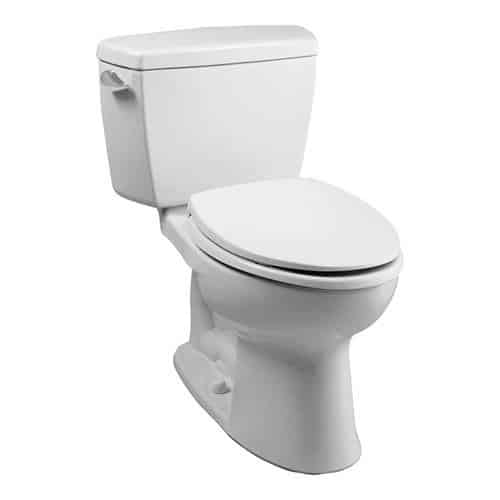
Since I bought and installed my first Toto Drake in 2007, I've continued to buy and install them in every house I’ve lived in. Simply put, this thing is amazing.
“TOTO” is a well-respected Japanese brand that I consider the BMW of plumbing fixtures. This company has MASTERED the design and functionality of toilets to the point that they use very little water and rarely clog (unless you’re trying to flush a newspaper or phone book down the toilet).
Even better than the impeccable design, this toilet has two flush modes, using approximately 0.8 gallons with a quick push-and-release, and using the full 1.6-gallon tank when you push-and-hold. This particular toilet comes in many variations, but the basic model is priced at less than $200 and comes in both round (ideal for smaller bathrooms) and elongated (for bathrooms with plenty of room). The low-maintenance, high-efficiency, high-quality design and reasonable price of this toilet make it a great choice for landlords who want the best for their tenants without unnecessarily wasting water.
TOTO also has some newer versions of this toilet (the TOTO Drake II) – one version that uses a maximum of 1.28 GPF, and another one that uses 1.0 GPF with all the same flushing power. These newer versions are a bit more expensive, but if you want to reduce your property's water consumption even more, these options are also available.
Delta Classic Single Handle Lavatory Faucet (1.5 GPM)
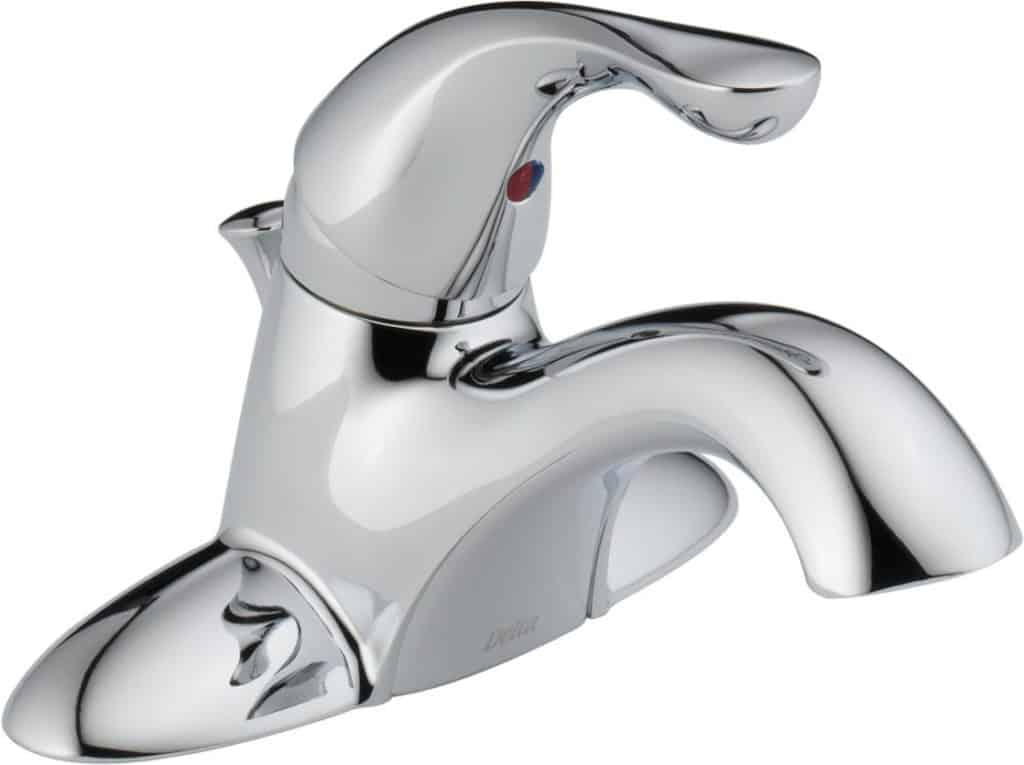
I have personally been using this faucet in my house for the better part of a decade, and after all this time, I don’t have any formal complaints about it. I'll only note that there is a slight “cheapness” factor to it. Looking at the picture, I initially assumed it was made entirely of metal. Still, it's made almost entirely of plastic (not that plastic is a bad thing per se, but the picture does make it look like a higher-quality item than it is).
This faucet puts out noticeably less water than the one I replaced it with, and even with less output, I've never been annoyed or bothered by it. I can still wash my hands and brush my teeth just as quickly, and the lower output has never gotten in the way of these basic, daily tasks.
Regardless of the VERY small issues (if you can even call them that), this faucet delivers as expected. The price is more than acceptable, considering the ultimate ROI it needs to deliver to justify this improvement.
Evolve Roadrunner II Shower Head (1.5 GPM)

Showers typically consume more water than any other plumbing fixture in the house, which means there is a TON of potential for savings here. A new shower head is also easy to install (no plumbers needed) and relatively inexpensive considering the money it can save, which makes it an easy opportunity to save a lot of money.
On the same coin, a showerhead is restricted to 1.5 gallons per minute, and some users will notice, especially if they aren't accustomed to a lower-flowing shower head. In my experience with this shower head, it does a decent job of dispersing the water evenly and maintaining fairly high water pressure. I won't say the restricted water consumption isn't noticeable on some level (because it is), but this one does a decent job of managing a very small amount of water.
Aside from the showerhead itself, another major consideration is the brilliant and innovative Ladybug Water-Saving Adapter, which can save thousands of gallons of wasted water over its lifespan – even when paired with a different, higher-flowing shower head.
Evolve also makes a 1.75 GPM and 2.0 GPM version of this shower head (for those concerned about not having enough water coverage), and even with this increased water flow, it's still a MAJOR improvement from the older showerheads that consumed up to 5.5 gallons per minute.
Delta Foundations Single Handle Kitchen Faucet (1.8 GPM)
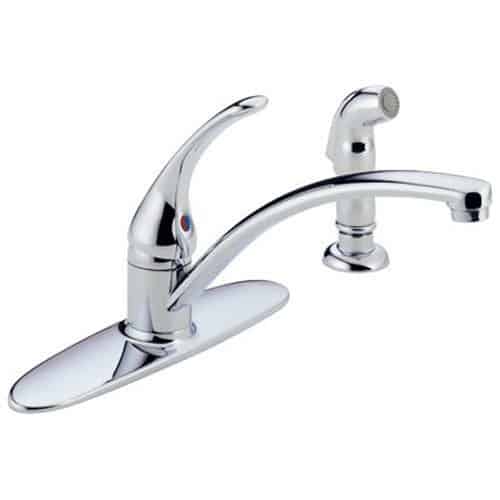
I used this exact faucet in my first house, which was a real workhorse. We used it every day for over three years, and performed flawlessly. This thing is built like a rock, looks sharp, and compliments the look of any kitchen without breaking the bank.
In my experience with this faucet, the water flow of 1.8 GPM didn't cause any issues or get in the way of our daily kitchen tasks. If anything, the water pressure from this faucet was a major improvement from the one we inherited with our house.
Delta also sells an aerator for this faucet that can restrict the water flow to 1.5 GPM. If you want to conserve even more water from the kitchen faucets in your rental properties, you can do it quite easily for just a few extra bucks (assuming your tenants don’t remove it on their own).
Are the Savings Worth It?
Let's look at the costs of replacing all the plumbing fixtures in first my duplex:
- 4 toilets at roughly $196.06 a piece ($784.24 total)
- 4 bathroom faucets at $69.65 a piece ($278.60 total)
- 2 kitchen faucets at $62.18 a piece ($124.36 total)
- 2 shower heads at $39.99 a piece ($79.98 total)
Ultimately, I looked at approximately $1,267.18 to overhaul the plumbing fixtures at my first property (assuming I did all the installation myself). I'm not sure what plumbers in Los Angeles or elsewhere charge, but it would add significantly to the overall bill.
According to energy.gov, the savings from these new plumbing fixtures should range from 25% to 60%. In my situation, I've been saving $300 – $400 per year since I made these improvements, which means it will take approximately four years for this initial investment to pay for itself, and then proceed to put another $300 – $400 in unwasted money back into my pocket each year (and possibly even more, assuming the cost of water continues to rise).
Again, given that water in my town is relatively cheap, this isn't necessarily a “jaw-dropping” cost savings, but I still think it was a worthwhile investment. Even though the payoff will be slow in my situation, there will eventually be a substantial payoff – and assuming I hold onto these properties for the next couple of decades (which I intend to), it's a benefit I will continue to realize for many years into the future.
And again, keep in mind – if my properties were in a more expensive water market, my savings would be MUCH more significant each year, and this upfront cost would easily pay for itself in less than a year — with a permanent savings of this same, higher amount every year after that.
In my opinion, if a landlord has a property in one of these more expensive markets and/or if their plumbing fixtures aren’t as efficient as they can be, these upgrades should be a pretty easy decision (and every year, they don’t make these improvements, they’re flushing money down the toilet).
It’s also worth noting that with replacing these plumbing fixtures, landlords will eliminate leaky faucets throughout their buildings, which is another overlooked cost that can waste an unbelievable amount of water and money every year.
Does It Make Financial Sense?
Here's how I see it… if a property already has fairly recent plumbing fixtures installed in its buildings, or if the building was constructed within the last quarter-century (with plumbing fixtures manufactured after 1992), the cost of buying new toilets, faucets, and showerheads simply for improved water efficiency will be notably more difficult (though not necessarily impossible) to justify.
Otherwise, for real estate investors who own older properties with older fixtures (which accounts for MANY of the rental properties currently on the market) — it should be fairly easy to justify investing in some updated plumbing fixtures that will waste less water and save substantial amounts of money in the long run.
I'd love to hear your thoughts for all the rental property owners out there!
- Have you installed new plumbing fixtures in any of your properties?
- If so, have you seen any noticeable improvements?
- If not, will you be installing more efficient fixtures soon?
Head over to the forum and share your thoughts!





